
| Home | FAQs | Rules | Archives | Articles | Jobs | Links | KWHSS | OSCAR | SCA.org |
Quick Reference: Bird Postures
One of the primary differences between beasts and birds is that the latter are commonly linked quite closely with a specific posture in period armory. Thus, in period armory, almost all displayed birds are eagles, only storks have the posture 'in their vigilance', only peacocks are 'in their pride' and only pelicans are 'in their piety'. The present Laurel thought on this is that birds who are represented in their period posture, displaying defining characteristics (more on this later) and were considered different in period will generally be considered different.
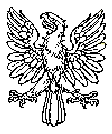 |
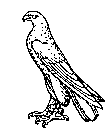 |
 |
| An eagle | A falcon | An owl |
The first group is that of the raptors: Chief among them is the Eagle, being the king of the air, much like the lion is the king of beasts. The eagle is normally seen displayed. Next is the falcon, which is seen as both rising and close in period armory. Finally, there is the owl which is always seen in period in the close guardant posture.
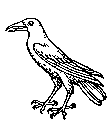 |
 |
 |
The next group is the general 'bird' group. The default posture for these is close and include birds such as the crow, duck and dove.
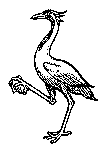 |
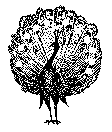 |
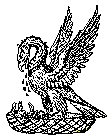 |
The final category is reserved for special birds who have postures which make them unique enough to render them different from other birds. These include the crane, peacock and the pelican.
Avian Postures
| Posture | Defining traits | stylised drawing | Example |
|---|---|---|---|
| Displayed | Wings and legs splayed |  |
 |
| Close | Wings close against the body and feet on ground |  |
 |
| Volant | Feet invisible, wings outstretched. Wings can be displayed or not. |  |
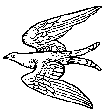 |
| Rising | Feet on ground, wings default to elevated and addorsed but may also be displayed. |  |
 |
| Close guardant | Normally only for owls - this is their default posture |  |
 |
| Pride | seen only with Peacocks. Close affronty with tailfeathers displayed |  |
|
| Vigilance | seen only with Cranes. Close with one leg raised, stone in claw |  |
|
| Vulning or Piety | seen only with Pelicans..normally with nest and chicks |  |
Wing postures
Like the beasts and their head postures, birds have wing position variants as well that are worth blazoning but not worth difference. However, we no longer blazon the position of the wingtips, inverted or not. These include the following:
| Posture | Defining traits | stylised drawing | Example |
|---|---|---|---|
| Addorsed | Both wings on same side of body |  |
 |
| Displayed | Wings on either side of body |  |
 |
| Elevated | Wingtips away from body |  |
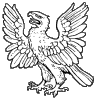 |
| Inverted | Wingtips tucked back towards body |  |
 |
Often, the two wing position variants will be used together, thus:
 |
 |
 |
 |
| Addorsed and elevated | Addorsed and inverted | Displayed and elevated | Displayed and inverted |
This page originally appeared in a Heraldic Primer originally created by Iulstan Sigewealding (Stephen Gold) and expanded/updated by Meradudd Cethin (Timothy Shead). Some minor formatting changes, fixes, and updates have been made to bring it in alignment with current practice.
The heraldry.sca.org site is copyright 1995-2024 Society for Creative Anachronism, Inc. The copyright of certain portions of heraldry.sca.org are retained by the original contributors as noted.
External links are not part of the heraldry.sca.org web site. Inclusion of a page or site here is neither implicit nor explicit endorsement of the site. Further, SCA, Inc. is not responsible for content outside of heraldry.sca.org. For information on how SCA uses collected and submitted data, please see the Privacy Policy.
Paper texture used with permission from GRSites.com.